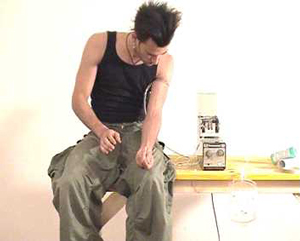

Exogenous versus endogenous
In the view of recent, fast-growing and processing technologies, like genetics, nano- and information technology, them declared possibilities and targets are to engage and modify in the anthropological development, the human being receives not only a new biological openness, but also it seems, that the utopia of a mentally and morally improved human could be fulfilled. Is this the second step of knowledge and/or the next chapter of evolution? So that reveals a basically total different question for scientists, theorists, philosophers and artists: not how to handle the being-thrown-into-the-world, but how to throw the being into the world.
„In the beginning was the word ...“ (Joh., chapter1) – This confession to the written word, which is the determining force for all religious, intellectual, political and cultural movements in industrialized west/occidental, is self-generating. And now the word itself wants to turn into flesh – the imaginary body of logos is searching for his materialization.
Along this I wanted my project understood and ask, in how far philosophy, its instrument is the word, is able to face this? Is it really possible to define an appropriate draft or image of being with the classical, traditional difference patterns of existing morals, ethics and philosophies? Or is this question already taken out of theorists hand by the self-dynamics of science and technology and given to their protagonists?
Otherwise the scientists need to give a justification for their scheme, because in view of the awaited results the decision of financial aid and facilities will be made as well as the (social) legitimation. And herein science is dependent on the conventional visualization techniques and the mediation and distribution through the arts and media.
Up to now most media and imagery dealing with the biogenetical topic draw a horrifying scenario or reproduce fashioned images out from the scientific visualization machines. As well as the scientific terminology and metaphors of the language surrounding the human genomics refer to traditional terms.
At first, it seems to be only a cognitive process remaining in the circle of affirmation what poses the question whether it is a case of non-possibility of imaginativeness or a case of a camouflage strategy.
In the first case it is referring to the above mentioned aspect, the act of ‘god-like’ creation, a philosophical dimension and with it a problem of representation. The second case gets a political dimension.